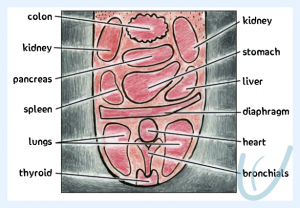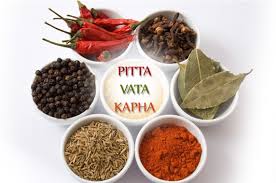When Ayurveda originated over 5,000 years ago in India, vadiyas (or Ayurvedic physicians) did not have access to the array of clinical tests, as we do in present day. Thus, the vaidyas used the classical method of eightfold examination in Ayurveda. This is known as ashta vidya pariksha in Sanskrit.
Ayurveda aims to treat the root cause of an illness rather than the symptoms. An Ayurvedic practitioner will determine an individual’s prakruti (or innate constitution) and their current state of imbalance, or vikruti. This is stated in terms of the three doshas or physiological constitutions: Vata, Pitta, and Kapha. The determination for each individual is made via eightfold examination in Ayurveda.

The first and most vital of the eightfold examination in Ayurveda is nadi pariksha or pulse assessment. Pulse is the most accurate determination of a person’s prakruti and vikruti. There are seven levels of pulse on each hand, including pulses for the organs as well as the tissues. Vata, pitta and kapha imbalances can be detected.
Another noteworthy assessment is jhiva pariksha or tongue diagnosis. Each part of the tongue correlates to an organ. Coating on the tongue indicates toxins in a region. Bumps, lines, and ridges are also noteworthy indicators of imbalances.
Just as the tongue tells a story of health, so does eye examination, or netra pariksha. The size, shape, and contour of the eye provide details on prakruti and vikruti. Puffy eyes or dark circles under the eyelids provide information on the kidneys and adrenals. Rings around the sclera or spots on various parts of the eye relate to imbalances with specific organs.

The manner in which a person speaks provides key information regarding vikruti. This is called shabda pariksha in the eightfold examination in Ayurveda. A person with a Vata imbalance will speak quickly and divergently. A Pitta dominated person will speak sharply and critically in an authoritative manner. An person whose Kapha is imbalanced will speak very slowly in a monotonous manner.
Much information about vikruti may also be gleamed from touch or sparsha pariksha. Touching the skin gives information about temperature and the dryness or oiliness of a person’s skin. Vata people run dry, while Pitta people have more oily skin. Vata is cold, while Pitta and Kapha are warmer. Palpating lymph nodes, glands, and organs also gives key evidence about how an organ may be functioning. These findings may be used in conjunction with pulse findings.
Examining a person’s physical form provides categorical details on each dosha. This method of akruti pariksha entails looking at a person’s frame and body mass. Vata people have a thin frame, Pitta people are medium sized and Kapha people are heavier. Lines on the face are indicative of organs which may be working under stress. Another key to diagnosis in akruti pariksha is nakha pariksha or the assessment of an individual’s nails. Each finger correlates to a particular organ. If there are pronounced ridges or indentations on a certain finger, that correlates to a weakness in the corresponding organ.

The final two methods of ashta vidya pariksha can be reported by client to the Ayurvedic practitioner. These are determinations regarding two waste products: urine and feces, or mutra pariksha and mala pariksha. The color and consistency of each determine the state of vikruti. If a person is chronically constipated, that is indicative of a Vata imbalance. Those prone to diarrhea have more of a Pitta imbalance.
Our body provides numerous clues to our physiology. The method of eightfold examination in Ayurveda gives the Ayurvedic practitioner key information about an individual’s vikruti. These details are all utilized in conjunction with a complete health history. Then the Ayurvedic practitioner can recommend the proper dietary guidelines, lifestyle suggestions, and herbal preparations to naturally restore balance to an individual.